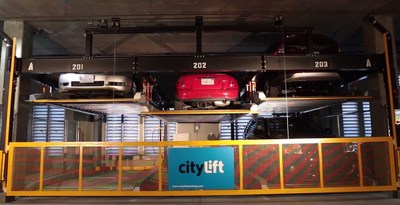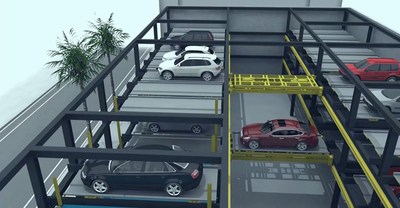OAKLAND, Calif., Jan. 19, 2017 /PRNewswire/ -- CityLift CEO, Scott Gable recently sat a on a speaker's panel at a conference called the "Future of Mixed Use Real Estate Development". As these panels typically go, it only took about 2 minutes before the conversation veered into parking.
One developer spoke up that they were truly stuck on what to do in their new mixed use project. Their city planning department was willing to relax parking requirements completely. However, their tenants would need parking today, and if they didn't provide enough parking the local community would actively resist the project, fearing the new influx of cars on their already cramped streets.
The developer was also worried in 10-15 years their development may not need as much parking if more people use ride sharing or alternative forms of transportation.
Should they make the investment to meet today's demand?
Should they under build today's demand even if it means losing some prospective tenants?
Would community resistance kill their project if they don't build enough parking?
Up to now parking has been a zero-sum game because of how conventional garages are designed and constructed. An average garage requires three to six times more square feet than the actual dimension of a car to accommodate drive aisles, ramps and standard parking space dimensions. Conventional garages are increasingly expensive to build.
What if the developer doesn't need the amount of parking in the future?
Would they be stuck with a concrete structure with low ceilings and ramps and no other purpose?
The way out of this dilemma is to USE AUTOMATED PARKING LIFTS today. Automated parking lifts are not a new concept, but up until now much of the development has occurred in Europe and Asia. In Japan alone there are over 1.6 million automated parking spaces in one form or another.
Based in Oakland, CA, CityLift Parking is building some of the most innovative, easy-to-use, and affordable automated technologies in the United States. CityLift reduces the square footage needed per car up to 80% by using vertical space more efficiently, eliminating ramps, concrete slabs and in some cases eliminating drive aisles altogether.
This means a developer can meet today's parking need with much less space, freeing up land for other uses.
Construction expenses also go down. For example, three car levels in an automated structure uses the same vertical space as a 2-level conventional garage. Construction hard costs are saved by eliminating an entire floor of concrete, an elevator stop, and ramps.
As for going below ground, the space savings per car can eliminate some or all of the need to go subterranean. The all-in cost of a fully subterranean garage can often be cut in half or more by using automated parking.
In addition, since parking lifts are equipment they can be depreciated over 7 years instead of the 29 years for a physical building, helping to improve the after tax returns in the early years of the project.
The best part is the space for automated parking lifts can be repurposed if parking demand goes down in 10-15 years. When the parking is no longer needed you disassemble the structure, move it out, and regain square footage for amenities or possibly even more rentable space. It's like getting a free option for the future without making a sacrifice on meeting today's needs.
Solving parking today doesn't need to be a dilemma. Automated parking lifts are an intelligent solution that's ready to meet your needs, both today and in the future- whatever that may hold.
| For more Information Contact |
Raymond Kahue |
| 510.345.0145 |
|
SOURCE CityLift Parking
Related Links
WANT YOUR COMPANY'S NEWS FEATURED ON PRNEWSWIRE.COM?
Newsrooms &
Influencers
Digital Media
Outlets
Journalists
Opted In


Share this article